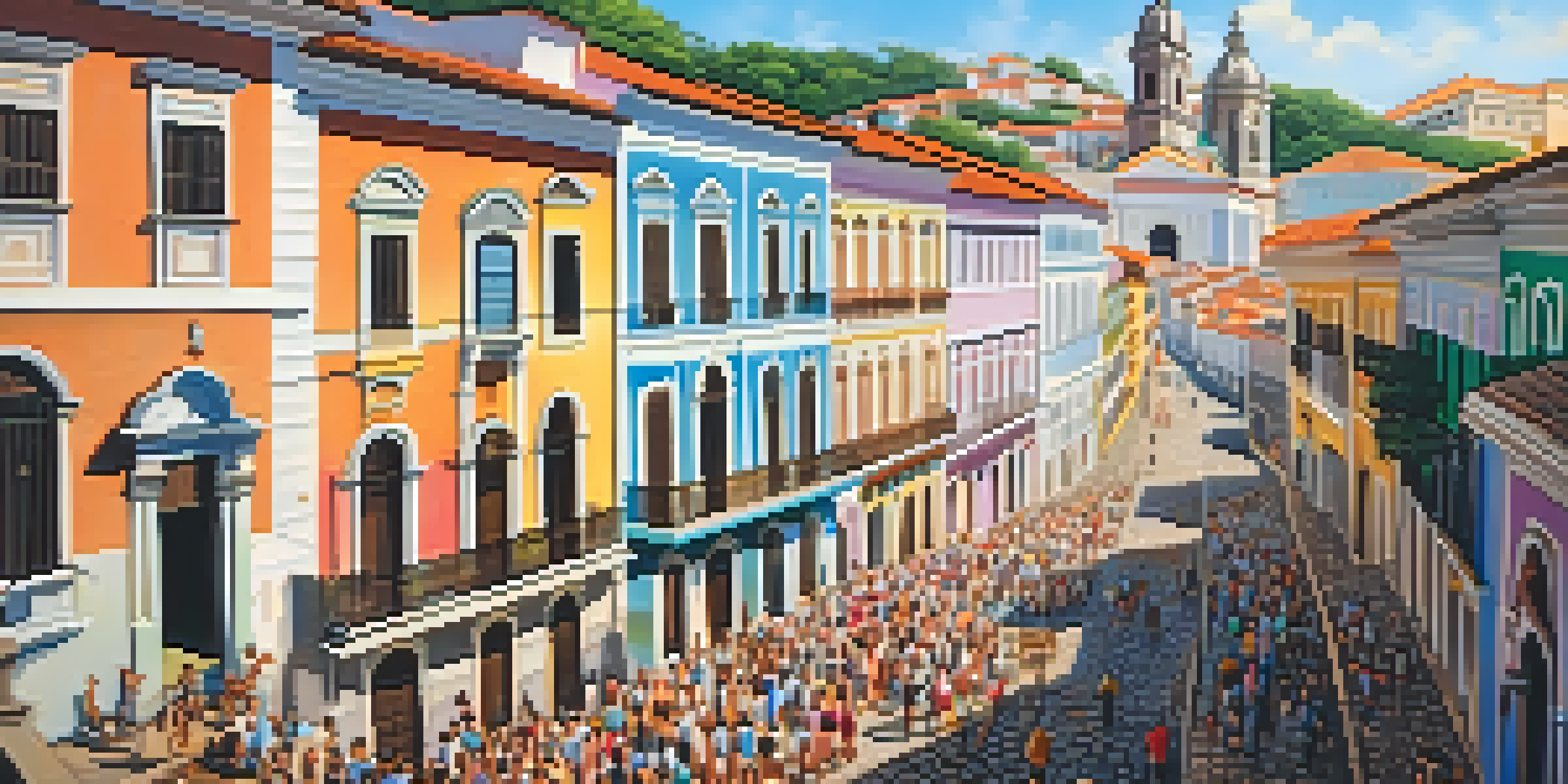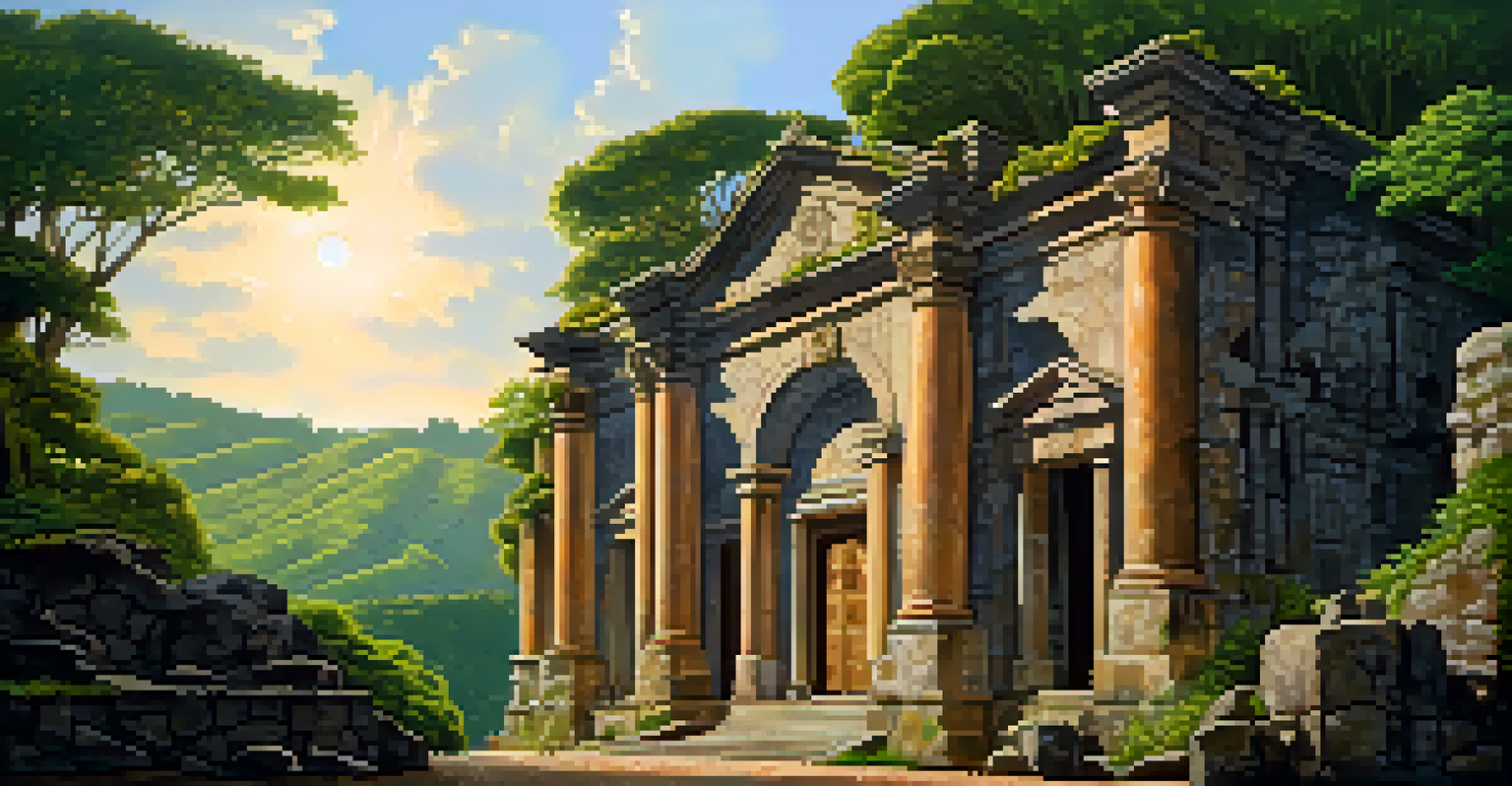Brazil's Architectural Marvels: A Journey Through Time

The Rich Tapestry of Brazil's Architectural Heritage
Brazil's architectural landscape is a vibrant tapestry woven from various cultural influences. From the indigenous designs to the Portuguese colonial styles, each era has left an indelible mark on the country's skyline. This rich heritage showcases not only the evolution of architectural techniques but also the diverse stories of its people.
Architecture is a visual art, and the buildings speak for themselves.
As you stroll through cities like Salvador and Ouro Preto, you can see how history and culture collide in every building. The colorful facades and ornate details reflect the unique blend of African, European, and indigenous elements that define Brazilian architecture. It's a visual journey that tells tales of resilience and creativity.
In this journey through time, we will explore some of the most iconic structures that symbolize Brazil's architectural evolution. Each marvel is not just a building; it's a testament to the country's artistic spirit and cultural diversity.
The Colonial Charm of Salvador's Pelourinho
Pelourinho, the historic center of Salvador, is a UNESCO World Heritage site that exudes colonial charm. The vibrant streets are lined with pastel-colored buildings that date back to the 17th and 18th centuries, showcasing baroque and neoclassical architecture. Walking through Pelourinho feels like stepping back in time, as the cobblestone streets echo with the sounds of music and celebration.

One cannot miss the stunning São Francisco Church, known for its intricate gold leaf interior and breathtaking altar. This architectural gem is a perfect example of the Baroque style that flourished during the colonial period. Every corner of Pelourinho is steeped in history, making it a must-visit for anyone interested in Brazil's architectural roots.
Brazil's Diverse Architectural Heritage
Brazil's architecture is a rich blend of indigenous, Portuguese, and African influences that reflect the country's cultural diversity and history.
Beyond its beauty, Pelourinho tells the story of Brazil's complex history, including the struggles and triumphs of its people. As you explore this historical neighborhood, you can appreciate how architecture serves as a narrative of cultural identity and resilience.
Rio de Janeiro: The Marvel of Modernist Architecture
Rio de Janeiro is not just famous for its beaches but also for its modernist architectural wonders. The city is home to several iconic structures designed by renowned architects like Oscar Niemeyer, whose work exemplifies the essence of modernism. The sleek curves and bold designs of buildings such as the Niterói Contemporary Art Museum are striking against the backdrop of Guanabara Bay.
The greatest buildings are the ones that bring people together.
One of the most celebrated examples is the Copan Building, an undulating structure that stands as a symbol of Rio's architectural innovation. With its fluid lines and organic shapes, it perfectly captures the spirit of the city. Visiting Rio offers a unique opportunity to see how modern architecture can harmonize with the natural landscape.
The blend of modernist principles with Brazilian culture creates a distinctive architectural identity that is both captivating and thought-provoking. Rio de Janeiro's skyline is a testament to the country's forward-thinking vision and artistic flair.
Brasília: A City Designed for the Future
Brasília, Brazil's capital, is a city that was meticulously planned and constructed in the 1960s, earning it the title of a modern architectural marvel. Designed by the visionary architect Oscar Niemeyer and urban planner Lúcio Costa, Brasília showcases futuristic buildings and wide avenues that reflect a break from traditional city layouts. The city's unique layout resembles an airplane, symbolizing progress and innovation.
Among its most iconic structures is the National Congress, characterized by its distinctive dome and bowl-shaped buildings. These structures are not only functional but also serve as a canvas for artistic expression, embodying the ideals of modernist architecture. Walking through Brasília feels like exploring an open-air museum of contemporary design.
Significance of Iconic Structures
Landmarks like Salvador's Pelourinho and Brasília's National Congress symbolize Brazil's architectural evolution and the stories of its people.
However, beyond the aesthetics, Brasília also raises important discussions about urban planning and social dynamics. As you navigate through its vast spaces, you can ponder the relationship between architecture and society, making it a fascinating destination for both architecture enthusiasts and curious minds.
The Vibrant Art Deco of São Paulo
São Paulo, Brazil's bustling metropolis, is a treasure trove of architectural styles, with Art Deco standing out as a significant influence. The city's skyline is peppered with stunning Art Deco buildings, showcasing elegant lines and decorative elements that reflect the style's popularity in the early 20th century. Landmarks like the Copan Building and the São Paulo Museum of Art epitomize this vibrant architectural movement.
Exploring neighborhoods like Higienópolis and Vila Madalena reveals a wealth of beautifully preserved Art Deco structures. These buildings not only capture the essence of a bygone era but also tell stories of São Paulo's economic growth and cultural evolution. The intricate details found in their facades invite admiration and wonder.
As you immerse yourself in São Paulo's Art Deco scene, you'll discover how architecture can mirror the city's dynamic spirit. Each building is a testament to the creativity and innovation that have shaped São Paulo into the cultural powerhouse it is today.
Iguazu Falls: Nature's Architectural Masterpiece
While discussing architecture, it's impossible to overlook the natural wonders that shape Brazil's landscape, with Iguazu Falls being a prime example. This breathtaking waterfall system is not just a natural phenomenon; it's a masterpiece that showcases nature's architectural prowess. The sheer power and beauty of the falls create a spectacle that leaves visitors in awe.
Surrounded by lush rainforest, the falls form a stunning backdrop that complements the architectural elements of visitor facilities designed to integrate with the environment. Walkways and viewpoints have been thoughtfully constructed to provide an immersive experience, allowing visitors to appreciate both the falls and the surrounding ecosystem.
Nature and Architecture Intertwined
Natural wonders like Iguazu Falls demonstrate that architecture extends beyond buildings, showcasing the harmony between human design and the environment.
Iguazu Falls serves as a reminder that architecture is not limited to buildings; it can also encompass the way we interact with and appreciate the natural world. The harmonious blend of nature and human design creates a unique experience that captivates the heart and soul.
The Enigmatic Ruins of São Miguel das Missões
The ruins of São Miguel das Missões are a testament to the Jesuit mission settlements established in the 17th century. These architectural remnants, located in the southern part of Brazil, reflect a unique fusion of European baroque and indigenous influences. The intricate stonework and layout of the mission complex highlight the Jesuits' commitment to education and cultural exchange.
Visitors to the site can explore the remains of the church and surrounding buildings, which transport them back to a time when spirituality and education were intertwined. The ruins stand as a haunting reminder of the complex history of colonization and the resilience of indigenous cultures.

As you walk through the site, you can reflect on the stories embedded in the stone, making it a profound experience that goes beyond mere sightseeing. São Miguel das Missões invites contemplation on the intersections of faith, culture, and history.
Cultural Significance of Brazil's Architectural Wonders
Brazil's architectural marvels are not merely structures; they are cultural symbols that tell the story of a nation. Each building, from colonial churches to modernist masterpieces, reflects the values, struggles, and aspirations of the Brazilian people. Architecture serves as a lens through which we can understand the social and political landscape of the country.
These architectural wonders also foster community and identity, providing spaces for gathering, celebration, and reflection. They are venues for cultural events, museums, and public spaces that encourage social interaction and cultural exchange. The architecture of Brazil is deeply intertwined with its vibrant culture and diverse population.
As we conclude our journey through Brazil's architectural marvels, it's clear that these structures are a celebration of creativity and resilience. They invite us to explore not only the physical spaces but also the stories and emotions that shape the Brazilian identity.